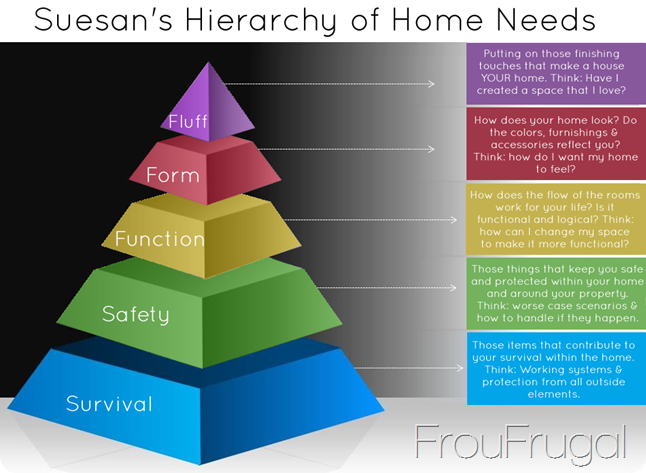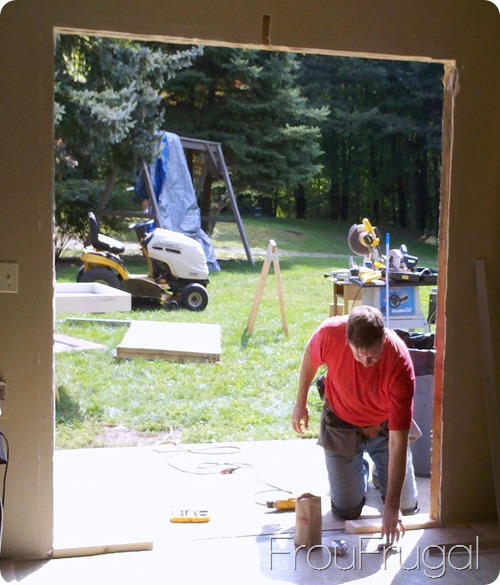Suesan’s Hierarchy of Home Needs

I’m on a roll. It’s Day 2 of the 31 Day Challenge and look at me go! Can I get a “Woot!?” As promised, I am starting off my series by sharing my philosophy on the needs of a home.
I’ve been working on this theory for awhile and it has its roots back in my college days.

I studied communications at Brigham Young University back in 80s and, in those days, it seemed like I could not take a course in my major without having to discuss Maslow’s Hierarchy of Needs.
I honestly got sick of Mr. Maslow and his needs, but he has some good points to consider. The basic premise Maslow put forth was that everyone has the same needs and that those needs have a hierarchy to them. Base needs must first be met before higher needs can become a priority.
This makes sense. If you don’t have adequate shelter, food or water, it’s hard to think about developing relationships or boosting your self-esteem.
I have found this same concept holds true when it is applied to the needs of our home. I’ve even made a hand-dandy graphic to illustrate the point.

If we are strictly following Maslow’s guidelines, we need to start at the bottom of the pyramid and work our way up.
Survival
These are the basics in your home: floors, ceilings, doors, windows, water, heating/cooling, electrical, plumbing, roof, foundation. The sad truth about these items is that money spent on this level is almost always expensive and rarely does the work result in a pretty picture. However, all of the items at this level directly impact the value of your investment. These type of items all need to be in working order to fully be able to live in the home. Some of these can lead to safety issues if not properly taken care of. Money spent on the basic, survival type elements of your home is always money well spent.
Now, don’t misunderstand me. When I say “doors” I don’t mean having a six panel door versus a hollow-core door. I mean do you have working doors in your home that protect you from outside elements? Think very, very basic here. Yes, you may have a door, like we did when we moved into our last house. But because the door threshold was rotted out, Replacing the Front Door was the first project we did in moving into the home.
Having lived in a 164-year-old house for the last year, most of my projects have been focused on this level. I haven’t blogged about most of them, but we have treated the well and installed a dehumidifier. We’ve worked on our heating and cooling systems (or lack thereof), we’ve dealt with electrical issues and plumbing issues. We are living with a plywood subfloor in the living room and we have fixed wall issues in the kitchen.
Safety
Safety needs are anything you need to do to keep your people and/or your property safe. This is pretty obvious, but I will just go over some items to consider. Do you have working doors/locks and do you have all the keys for them? Do all your windows open and close and safely latch? Do you have working smoke and carbon monoxide detectors in every bedroom and on every level of the house? Are they wired together to ring throughout the house? Do you have a fire escape plan for each bedroom of the house, particularly for those on upper floors? Does your basement have windows that people could fit through to escape a fire in your house? Is the electrical wiring in your home safe and grounded?
My questions aren’t meant to be exhaustive but think about those things your house may need to keep people safe. Having lived through a home fire, I can assure you that they do happen and it is nothing you ever want to go through. Take time to figure out the safety needs of your home and spend the money to address those needs.
Function
Hubs and I once went to a Homearama and the first house we saw was so cute and from the outside it was everything I had ever wanted in a house. I turned to Hubs and said, “You’d better hope that house is terrible on the inside or I’m going to be pretty hard to live with.” Guess what? The beauty of that house was only skin deep, because inside it was a hot mess.
As we walked through the rooms we were stunned by how poorly it was laid out. The function of the house was horrible and I easily walked away from that house knowing I would never want to live there.
Function is often a hard thing to change. Currently, our home has a laundry room downstairs in the middle of our family room. Nothing closes it off from the family room, it’s just there. However, all the bedrooms in the house are upstairs and Hubs and I have dreamed of relocating the laundry room upstairs. Since we are moving, we let the next owners deal with it, but making a home function for how your family uses the home is an important thing to consider.
Having lived in 21 different homes in our married life, I can honestly state that a good portion of function issues can be solved with some good, old-fashioned creativity. If you are in the market for a new home, though, pay particular attention to not just the look of the home, but how it would function for your family. I have found that function problems that can not be changed are some of my biggest complaints with a home.
Form
This is the pretty level. Form is all about how your house looks and feels. This is where the discussion of 6-panel vs. hollow core doors comes into play and whether those doors will be white or black or some other color. How does your home feel? Does it reflect your personality? Form is about the wall colors and the furnishings and the drapes and they style. It’s about the vibe and the tone and the voice of your style.

I have been in a few houses in my day that totally struck me for how right the owners got this element of their home. My friend, Linda, is one such person. She is happy and spunky and stylish and her home illustrates that. Everything in her home highlights her and her husband’s personality and if you walked into their home but didn’t know them, you would totally know them after leaving. It’s just a delightful reflection of who they are.
I’m still trying to get to the form stage. I’m getting there with my kitchen and I will be sad to leave this kitchen behind. Form-wise, it will be everything I love. Function-wise, I will gladly walk away, but leaving my brick wall and farmhouse sink and barn wood island will be hard to do.
Fluff
It’s hard to distinguish this level from the Form Needs. I really wanted to call this the Pillow level. When I see someone switch out perfectly good pillows on their couch for other perfectly good pillows, I get a bit jealous. For the last two years I have been living so far down the pyramid that the Fluff level seems unattainable.

Fluff to me is about seasonally decorating, or swapping out accessories to change up the mood for a while. It’s simply fluffing the nest. Don’t get me wrong. I am in no way being critical of anyone who fluffs. I love the fluff. I wish I could fluff. I mean, I guess I could, but when your floor is paint-splattered plywood, it’s hard to care about the couch pillows. See? That Maslow was on to something.
So there you have it. Suesan’s Hierarchy of Home Needs. Unlike Maslow, my needs lists is a little more forgiving. When it comes to your home, I think you can work on some areas at the fluff level while maybe another spot of your home is focused on function or form.
I do think it’s essential to carve out some part of your home where you are working on the upper levels. Having lived in a construction zone for the last year, I can assure you that it is utterly essential to find that part of your home that you can make pretty and functional and “you.” Find that spot and get your fluff on.
This has me thinking, am I the only bottom dweller, or are there others here? Are most of your fluffers or are you working on another level? Did I miss something you think I should have included? I’d love to know.

